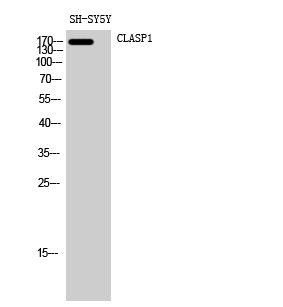CLASP1 Polyclonal Antibody
- Catalog No.:YT0941
- Applications:WB;IHC;IF;ELISA
- Reactivity:Human;Mouse
- Target:
- CLASP1
- Gene Name:
- CLASP1
- Protein Name:
- CLIP-associating protein 1
- Human Gene Id:
- 23332
- Human Swiss Prot No:
- Q7Z460
- Mouse Gene Id:
- 76707
- Mouse Swiss Prot No:
- Q80TV8
- Immunogen:
- The antiserum was produced against synthesized peptide derived from human CLASP1. AA range:1171-1220
- Specificity:
- CLASP1 Polyclonal Antibody detects endogenous levels of CLASP1 protein.
- Formulation:
- Liquid in PBS containing 50% glycerol, 0.5% BSA and 0.02% sodium azide.
- Source:
- Polyclonal, Rabbit,IgG
- Dilution:
- WB 1:500 - 1:2000. IHC 1:100 - 1:300. ELISA: 1:40000.. IF 1:50-200
- Purification:
- The antibody was affinity-purified from rabbit antiserum by affinity-chromatography using epitope-specific immunogen.
- Concentration:
- 1 mg/ml
- Storage Stability:
- -15°C to -25°C/1 year(Do not lower than -25°C)
- Other Name:
- CLASP1;KIAA0622;MAST1;CLIP-associating protein 1;Cytoplasmic linker-associated protein 1;Multiple asters homolog 1;Protein Orbit homolog 1;hOrbit1
- Observed Band(KD):
- 169kD
- Background:
- cytoplasmic linker associated protein 1(CLASP1) Homo sapiens CLASPs, such as CLASP1, are nonmotor microtubule-associated proteins that interact with CLIPs (e.g., CLIP170; MIM 179838). CLASP1 is involved in the regulation of microtubule dynamics at the kinetochore and throughout the spindle (Maiato et al., 2003 [PubMed 12837247]).[supplied by OMIM, Mar 2008],
- Function:
- function:Microtubule plus-end tracking protein that promotes the stabilization of dynamic microtubules. Required for the polarization of the cytoplasmic microtubule arrays in migrating cells towards the leading edge of the cell. May act at the cell cortex to enhance the frequency of rescue of depolymerizing microtubules by attaching their plus-ends to cortical platforms composed of ERC1 and PHLDB2. This cortical microtubule stabilizing activity is regulated at least in part by phosphatidylinositol 3-kinase signaling. Also performs a similar stabilizing function at the kinetochore which is essential for the bipolar alignment of chromosomes on the mitotic spindle.,PTM:Phosphorylated upon DNA damage, probably by ATM or ATR.,similarity:Belongs to the CLASP family.,similarity:Contains 7 HEAT repeats.,subcellular location:Localizes to microtubule plus ends. Localizes to centrosomes, kinetochor
- Subcellular Location:
- Cytoplasm, cytoskeleton. Cytoplasm, cytoskeleton, microtubule organizing center, centrosome . Chromosome, centromere, kinetochore. Cytoplasm, cytoskeleton, spindle. Golgi apparatus, trans-Golgi network . Localizes to microtubule plus ends. Localizes to centrosomes, kinetochores and the mitotic spindle from prometaphase. Subsequently localizes to the spindle midzone from anaphase and to the midbody from telophase. In migrating cells localizes to the plus ends of microtubules within the cell body and to the entire microtubule lattice within the lamella. Localizes to the cell cortex and this requires ERC1 and PHLDB2.
- Expression:
- Brain,Endometrium carcinoma cell line,Epithelium,Eye,Platelet,Poole
- June 19-2018
- WESTERN IMMUNOBLOTTING PROTOCOL
- June 19-2018
- IMMUNOHISTOCHEMISTRY-PARAFFIN PROTOCOL
- June 19-2018
- IMMUNOFLUORESCENCE PROTOCOL
- September 08-2020
- FLOW-CYTOMEYRT-PROTOCOL
- May 20-2022
- Cell-Based ELISA│解您多样本WB检测之困扰
- July 13-2018
- CELL-BASED-ELISA-PROTOCOL-FOR-ACETYL-PROTEIN
- July 13-2018
- CELL-BASED-ELISA-PROTOCOL-FOR-PHOSPHO-PROTEIN
- July 13-2018
- Antibody-FAQs
- Products Images

- Western Blot analysis of SH-SY5Y cells using CLASP1 Polyclonal Antibody diluted at 1:2000

- Immunohistochemistry analysis of paraffin-embedded human testis tissue, using CLASP1 Antibody. The picture on the right is blocked with the synthesized peptide.

- Western blot analysis of lysates from Jurkat cells, using CLASP1 Antibody. The lane on the right is blocked with the synthesized peptide.



